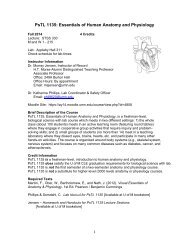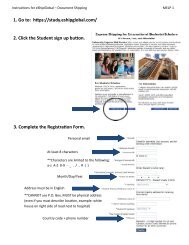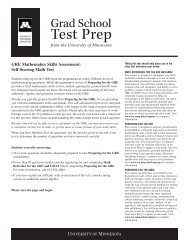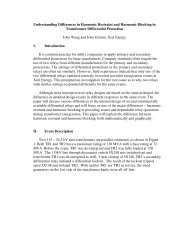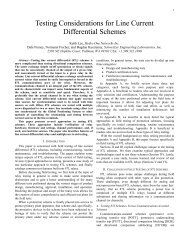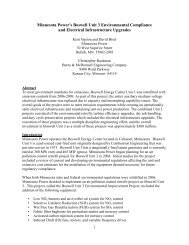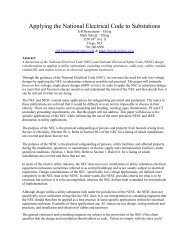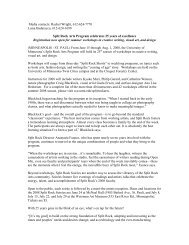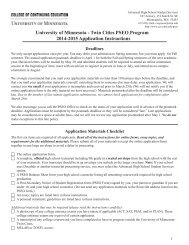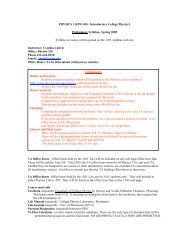Differential Protection for Power Transformers With Non-Standard ...
Differential Protection for Power Transformers With Non-Standard ...
Differential Protection for Power Transformers With Non-Standard ...
Create successful ePaper yourself
Turn your PDF publications into a flip-book with our unique Google optimized e-Paper software.
<strong>Differential</strong> <strong>Protection</strong> <strong>for</strong> <strong>Power</strong> Trans<strong>for</strong>mers<br />
<strong>With</strong> <strong>Non</strong>-<strong>Standard</strong> Phase Shifts<br />
Lubomir Sevov, Zhiying Zhang, Ilia Voloh, and Jorge Cardenas, General Electric Digital<br />
Energy - Multilin<br />
Abstract - The current differential protection is the most<br />
popular protection <strong>for</strong> trans<strong>for</strong>mers, providing good fault<br />
sensitivity, selectivity and security.<br />
Depending on the application, the trans<strong>for</strong>mer size, shape,<br />
winding connections vary. Some common power system<br />
applications require installation of two- or three-winding<br />
conventional power trans<strong>for</strong>mers or autotrans<strong>for</strong>mers, while<br />
others require phase shifting trans<strong>for</strong>mers (PST), Scott<br />
trans<strong>for</strong>mers, LeBlanc trans<strong>for</strong>mers, Zig-Zag grounding<br />
trans<strong>for</strong>mers, or converter trans<strong>for</strong>mers. Applying differential<br />
protection to conventional type power trans<strong>for</strong>mers with<br />
“standard” phase shifts of 30 degrees, or multiples of 30<br />
degrees is trivial. However, applying this protection to<br />
trans<strong>for</strong>mers with non-standard phase shifts is challenging <strong>for</strong><br />
the protection engineer. Current Trans<strong>for</strong>mers (CTs) installed<br />
in non-common locations adds even more to the complexity of<br />
applying the protection correctly. The later is associated with<br />
special CT – relay connections, correct computation of<br />
winding currents, phase angles, and selection of protective<br />
device supporting such applications.<br />
The paper provides essential knowledge on the trans<strong>for</strong>mer<br />
differential protections throughout theory and application<br />
examples. Current trans<strong>for</strong>mers and relay connections, as well<br />
as computation of trans<strong>for</strong>mer setup settings with standard<br />
and non-standard phase shift are covered.<br />
Index Terms – Scott trans<strong>for</strong>mer, LeBlanc trans<strong>for</strong>mer, Phase<br />
shifting trans<strong>for</strong>mers, Converter Trans<strong>for</strong>mers, Phase and<br />
Magnitude compensations<br />
I. INTRODUCTION<br />
The technological advancements in the design of relay<br />
hardware and the development of better algorithms <strong>for</strong><br />
protection of power trans<strong>for</strong>mers enabled the power system<br />
engineers to apply differential protection not only to<br />
conventional power trans<strong>for</strong>mers, but also to trans<strong>for</strong>mers with<br />
non-standard phase shifts. We find those non-standard phase<br />
shifts between the winding currents from Phase Shifting<br />
Trans<strong>for</strong>mers (PSTs), Converter trans<strong>for</strong>mers, Scott and<br />
LeBlanc trans<strong>for</strong>mers.<br />
II.<br />
REVIEW OF DIFFERENTIAL PROTECTION<br />
FOR TRANSFORMERS WITH STANDARD<br />
PHASE SHIFT<br />
Almost all of the medium and big size conventional<br />
trans<strong>for</strong>mers from either the distribution or the transmission<br />
power system are protected by current differential protection.<br />
The minimum data that one provides to the trans<strong>for</strong>mer<br />
differential relay requires entering in<strong>for</strong>mation on the<br />
trans<strong>for</strong>mer capacity (kVA or MVA), winding phase-phase<br />
voltages, current trans<strong>for</strong>mer ratings, selection of trans<strong>for</strong>mer<br />
winding connections, phase shifts, and whether there is<br />
grounding within the zone of protection. More settings would<br />
be needed if the relay has provisions <strong>for</strong> on-load tap changer<br />
(OLTC) monitoring, which could impact the normal operation<br />
of the main differential protection. Further, the entered data is<br />
used by the relay to per<strong>for</strong>m winding currents compensation,<br />
and compute the correct differential and restraint currents. The<br />
final step is associated with fetching the calculated differential<br />
and restraint currents into a set of differential/restraint criteria<br />
(characteristic) <strong>for</strong> defining differential protection operation or<br />
no operation.<br />
A. Winding Currents Magnitude Compensation<br />
Every trans<strong>for</strong>mer is characterized by its power capacity,<br />
voltage trans<strong>for</strong>mation ratio, winding, and mutual impedances.<br />
While the power capacity is mostly dependent on the size of<br />
the iron magnetic core, the trans<strong>for</strong>mer voltage ratio is solely<br />
dependent on the amper-turns of the windings wound around<br />
the same core leg. For example a two winding 37.5MVA<br />
D/Y1 trans<strong>for</strong>mer with winding voltages of 69kV and 13.8kV<br />
has a voltage ratio of 5:1. Neglecting the power consumed by<br />
the trans<strong>for</strong>mer, both windings are rated to transfer the same<br />
37.5MVA power. This means that the ratio between the<br />
winding currents need be the same, but in reverse proportion.<br />
The current from the 13.8kV winding will be 5 times higher<br />
than the current from the 69kV winding. The nominal currents<br />
<strong>for</strong> each winding is computed using the following equations:<br />
MVA<br />
IN ( w1)<br />
= (1)<br />
kV ( w1)*<br />
3<br />
I<br />
N ( w 2) =<br />
MVA<br />
kV ( w 2)*<br />
3<br />
To apply the protection correctly, the current trans<strong>for</strong>mers<br />
from both windings should measure and input the winding<br />
currents to the relay within the same reversed ratio. This<br />
however in most of the cases is not possible, as the primary<br />
ratings of the CTs used to replicate the winding currents within<br />
the range of secondary amps, are different than the winding<br />
nominal currents. The CTs are build with standard<br />
primary/secondary turns providing standard primary rated<br />
currents. The CTs are selected with primary current ratings of<br />
at least 1.2 – 1.5 times bigger than the winding nominal<br />
current. For example, if the nominal current <strong>for</strong> the 69kV side<br />
1
equals 313.7 Amps, the selected CT primary should not be less<br />
than 400 A. Another factor <strong>for</strong> CT selection is the capability of<br />
the CT to replicate high fault currents without significant<br />
saturation. Hence the mismatch between the currents measured<br />
by the relay and the currents needed <strong>for</strong> providing the<br />
differential protection is evident. To make it simple, the user<br />
selects a magnitude reference winding with meaning of<br />
winding phase-phase voltage and winding CT primary, and the<br />
algorithm computes the magnitude compensation coefficients,<br />
by which the non-reference winding currents are scaled. If<br />
winding 1 is selected as a reference winding, the magnitude<br />
compensation coefficient <strong>for</strong> winding 2 would be:<br />
M 1 - magnitude reference winding<br />
1 ( w1)<br />
=<br />
kV ( w2)*<br />
CTprim<br />
( w 2)<br />
M2(<br />
w 2) = (2)<br />
kV ( w1)*<br />
CTprim<br />
( w1)<br />
For the above example, with winding 1 CT (500:5), and<br />
winding 2 CT (2000:5), the currents from winding 2 CTs<br />
would be multiplied by magnitude compensation factor of 0.8.<br />
Wye winding shifted by 30° degrees from the Delta currents<br />
looks like shown on figure 1-a,b,c,d:<br />
a) Wye currents lag Delta currents by 30° degrees<br />
ia Y<br />
IC<br />
ib Y<br />
IA<br />
B. Winding Currents Phase Shift Compensation<br />
The windings wound on each of the three single core legs<br />
from a three-phase trans<strong>for</strong>mer can be connected in a number<br />
of ways to satisfy the application of the trans<strong>for</strong>mer in the<br />
power system. Some windings are connected in “Star” (Wye<br />
connection), with the start point either grounded or<br />
ungrounded. Others are connected in Delta arrangement to<br />
provide ground isolation. When the three individual primary<br />
windings are connected in the exact same way as the three<br />
individual secondary windings, no phase shift is accounted.<br />
Phase shift is accounted between the primary and secondary<br />
winding, when the connection arrangement of the three<br />
secondary windings is different than the one of the three<br />
individual primary windings.<br />
In the past, the phase shift compensation has been done<br />
externally, by connecting the CTs from the Wye winding in<br />
Delta, and the ones from the Delta winding in Wye. This way<br />
the phase shifting compensation is per<strong>for</strong>med by the Delta CTs<br />
from the Wye winding. The impact of the Delta and the Wye<br />
connected CTs placed respectively on both the Wye and the<br />
Delta sides of the trans<strong>for</strong>mer is as follow:<br />
• Per<strong>for</strong>m external phase shift compensation introducing<br />
currents with 180° degrees phase shift to the relay ready<br />
<strong>for</strong> magnitude matching and differential summation.<br />
• Eliminate zero sequence currents (Delta connected CTs)<br />
from the grounded Wye winding and match the zero<br />
sequence free currents measured from the Wye<br />
connected CTs on the Delta winding.<br />
In the modern time, the external phase shift compensation is<br />
not so common, as the new digital relays can per<strong>for</strong>m the<br />
phase shift compensation automatically. The CTs from both<br />
sides of the trans<strong>for</strong>mer are connected in Wye, meaning that<br />
the currents introduced to the relay terminals have the same<br />
trans<strong>for</strong>mer phase shift plus 180 degrees incurring from the<br />
mirrored polarity of both winding CTs. These relays measure<br />
the shifted winding currents, and apply a set of equations to do<br />
the phase shifting correction. For example, the set of equations<br />
(3) used to phase compensate the currents measured from the<br />
b) Wye and Delta currents from Wye connected CTs<br />
measured by the relay<br />
ia Y<br />
IC<br />
IB<br />
IB<br />
c) Phase shifting of the Wye currents<br />
ia Y comp<br />
IC Δ<br />
IB Δ<br />
ib Y comp<br />
ic Y comp<br />
IA Δ<br />
d) Phase compensated Wye and Delta currents<br />
Fig. 1 Phase shift compensation stages<br />
The applied set of equations depends on the type of<br />
trans<strong>for</strong>mer group selected on the relay. The standard phase<br />
shifts seen on conventional type power trans<strong>for</strong>mers is in<br />
multiples of 30° degrees, so that many trans<strong>for</strong>mer differential<br />
ic Y<br />
ib Y<br />
IA<br />
ic Y<br />
2
protection relays provide a pre-set table <strong>for</strong> selection of the<br />
desired trans<strong>for</strong>mer type. The table contains combinations of<br />
Wye, Delta and Zig-Zag windings <strong>for</strong> two and three winding<br />
trans<strong>for</strong>mers with standard phase shifts that are in multiples of<br />
30° degrees angles. As seen further, this approach of defining<br />
the trans<strong>for</strong>mer phase shift to the trans<strong>for</strong>mer protective relay<br />
is not very sufficient <strong>for</strong> some trans<strong>for</strong>mers with non-standard<br />
phase shifts.<br />
iaΥ<br />
− ibΥ<br />
iaΥ<br />
comp<br />
=<br />
3<br />
ibΥ<br />
− icΥ<br />
ibΥ<br />
comp<br />
=<br />
(3)<br />
3<br />
icΥ<br />
comp<br />
ic<br />
=<br />
Υ<br />
− ia<br />
3<br />
Υ<br />
V L<br />
Θ<br />
X<br />
sides<br />
SOURCE<br />
- per unit voltage of the Load side<br />
- phase angle difference between VS<br />
and V L<br />
- per unit reactance between the Source and Load<br />
SERIES<br />
UNIT<br />
LOAD<br />
III.<br />
TRANSFORMERS WITH NON-STANDARD<br />
PHASE SHIFTS<br />
EXCITING<br />
UNIT<br />
Depending on the core-winding construction, some power<br />
trans<strong>for</strong>mers do not introduce a standard phase shift of 30°, or<br />
multiples of 30° degrees. Employing differential protection <strong>for</strong><br />
such trans<strong>for</strong>mers is not straight <strong>for</strong>ward, and requires more<br />
analysis. The main concerns would be to define the following:<br />
• zone of protection, and places of current trans<strong>for</strong>mers<br />
• winding currents and phase shifts<br />
• special CTs - relay terminals connections<br />
• selection of protective relay that can be successfully<br />
applied without the need of connecting any costly<br />
auxiliary CTs or equipment in general<br />
A. Phase Shifting Trans<strong>for</strong>mers<br />
The Phase Shifting Trans<strong>for</strong>mers (PSTs) are used to control<br />
the active and reactive power flow through a line by varying<br />
the phase angle between its source and load voltages. The PST<br />
controls the power by inserting regulated quadrature voltage in<br />
series with the line to neutral voltage of the series winding<br />
(Fig.2). There are different types PSTs, depending on their<br />
application and construction: with or without Load Tap<br />
Changer(LTC), PSTs with Delta/Wye or Wye/Wye exciting<br />
unit configuration, with or without voltage regulating winding,<br />
or hexagonal designed. They also differ by power and voltage<br />
ratings, and provide different ranges of phase angle regulation.<br />
A conventional type PST (Fig.2) consists of two units: Series<br />
Unit with secondary winding connected in Delta, and an<br />
Exciting Unit of Wye connected primary and secondary<br />
windings with grounded neutrals. The Load Tap Changer is<br />
located on the secondary Wye winding from the Exciting unit,<br />
and is used to control the quadrature voltage magnitude used to<br />
shift the angle of the Load side voltage with respect to the<br />
Source side voltage. The power flow between the Source and<br />
Load sides of the PST can be approximated by the following<br />
equation:<br />
VS<br />
* VL<br />
*sin Θ<br />
P =<br />
(4)<br />
X<br />
where,<br />
P - real power flow per unit<br />
V - per unit voltage of the Source side<br />
S<br />
Fig.2 Typical PAR configuration<br />
Normally two differential protections are employed to<br />
protect the Phase Shifter: 87P called primary differential<br />
protection with zone of protection that includes the series<br />
winding and the grounded Wye primary winding from the<br />
exciting unit, and 87S called secondary differential protection,<br />
including the Delta secondary winding from the series unit,<br />
and the tapped secondary winding from the exciting unit.<br />
Figure 3 shows the distribution of phase A currents through the<br />
Source and Load sides, as well as the excitation winding used<br />
as inputs <strong>for</strong> the 87S phase A differential protection.<br />
A<br />
B<br />
C<br />
Isa<br />
Ila<br />
I'ea = k/2 [ ( Isc + Ilc ) - ( Isb + Ilb ) ]<br />
Fig.3 87S - the PST secondary differential protection<br />
The differential current <strong>for</strong> each phase is expressed as a<br />
summation of the currents from the corresponding Source,<br />
Load and excitation sides:<br />
v v v k v v v v<br />
I da = I sa + I la + [( I sc + I lc)<br />
− ( I sb + I lb)]<br />
2<br />
v v v k v v v v<br />
I db = I sb + I lb + [( I sa + I la)<br />
− ( I sc + I lc)]<br />
(5)<br />
2<br />
v v v k v v v v<br />
I dc = I sc + I lc + [( I sb + I lb)<br />
− ( I sa + I la)]<br />
2<br />
where,<br />
I r<br />
sa<br />
I r<br />
la<br />
is the phase A primary current source side<br />
is the phase A primary current load side<br />
3
v k v v v v<br />
I ' ea = [( I sc + I lc)<br />
− ( I sb + I lb)]<br />
is the phase A exciting<br />
2<br />
current<br />
k is the series unit turns ratio<br />
Working out with the Source, Load, and exciting unit current<br />
per phase, one can arrive to the conclusion that the angle (Fig.<br />
4) between the current (summation of the source and load<br />
currents), and the exciting unit current is 90° degrees. This<br />
angle has to be reflected in the trans<strong>for</strong>mer setup to assure<br />
correct phase shift compensation.<br />
connection arrangement. The arrangement is dictated by the<br />
two individual trans<strong>for</strong>mers <strong>for</strong>ming the Scott connections,<br />
v v<br />
accounting <strong>for</strong> the current ( ia − ic)<br />
trans<strong>for</strong>med into im<br />
current, and current ib trans<strong>for</strong>med into it current.<br />
The Scott trans<strong>for</strong>mer setup per<strong>for</strong>med on the relay requires<br />
three windings configuration, and entering data <strong>for</strong> winding<br />
power, voltages, connections, as well as the phase shifts.<br />
Inputs <strong>for</strong> winding 1 is the “it” current with CT secondary<br />
connected to phase A relay terminal, and current “im” with CT<br />
secondary connected to phase C terminal (Fig.7). Phase B<br />
terminal remains open.<br />
A<br />
B<br />
C<br />
Vab<br />
Vbc<br />
Vca<br />
Fig.4 Angle difference between S+L current and the exciting<br />
current<br />
Issue #1: The PST setup in the trans<strong>for</strong>mer protection relay<br />
need to reflect Y0/Y0/D9 trans<strong>for</strong>mer, which is not a standard<br />
type trans<strong>for</strong>mer, hence not in the list of selection <strong>for</strong> many<br />
relays providing trans<strong>for</strong>mer differential protection.<br />
B. Scott and LeBlanc Trans<strong>for</strong>mers<br />
Scott trans<strong>for</strong>mers are economical converters between threeand<br />
two-phase systems, and mostly used to supply power <strong>for</strong><br />
two-phase furnaces or two-phase motors from a three-phase<br />
system. Figure 5 bellow shows a Scott trans<strong>for</strong>mer connection<br />
by the means of two single-phase trans<strong>for</strong>mers with three<br />
phase inputs and two-phase outputs. The primary winding of<br />
the “teaser” trans<strong>for</strong>mer is center tapped and is connected to<br />
the three-phase system, where its secondary winding is<br />
connected to a two-phase circuit. The other trans<strong>for</strong>mer called<br />
“main” has one end of its primary winding connected to the<br />
third phase from the three-phase system, and the other end<br />
connected to the center tap of the “teaser” primary winding.<br />
A<br />
S<br />
B<br />
" MAIN "<br />
" TEASER "<br />
R<br />
Fig. 5 Scott trans<strong>for</strong>mer construction and currents<br />
Normally one current trans<strong>for</strong>mer (CT) is available on each<br />
phase from the three phases side (Fig.6), and on each phase<br />
from the two-phase side. All those CTs are used as inputs <strong>for</strong><br />
the trans<strong>for</strong>mer percent differential protection, under special<br />
C<br />
Ic<br />
Ia<br />
90∠<br />
Ib<br />
im<br />
it<br />
ib ia ic<br />
3 N 1<br />
2<br />
N1<br />
N 2<br />
N2<br />
it<br />
im<br />
Vt<br />
Vm = Vt<br />
Vm<br />
87T<br />
Fig. 6 Scott trans<strong>for</strong>mer connections <strong>for</strong> 87T protection<br />
For example, a 100MVA Scott trans<strong>for</strong>mer with<br />
HV=154kV, and LV = 55kV can be set as follow:<br />
Each LV winding gets 50% of the total power, meaning that<br />
winding 1 will have setting of 50MVA <strong>for</strong> the power, and<br />
55kV as phase voltage. The current is then calculated as:<br />
50MVA<br />
im = it = = 909Amps<br />
55kV<br />
To balance “im” current from winding 1 - phase A, the<br />
current “Ib” connected to phase A/CT bank # 2, need be<br />
calculated.<br />
The turns ratio of the two windings from the “main”<br />
trans<strong>for</strong>mer is 86.6%N1: N2 primary/secondary, so that the<br />
corresponding voltage of the primary winding on phase B is<br />
154kV<br />
* 3<br />
calculated as: V W 2 = = 133. 4kV<br />
. There<strong>for</strong>e the<br />
2<br />
voltage setting of winding 2 is set to 133.4kV. The current<br />
flowing through the main trans<strong>for</strong>mer primary winding - phase<br />
100MVA<br />
B is calculated as Ib =<br />
= 375Amps<br />
154kV<br />
* 3<br />
The current “ it ” flowing through the secondary winding<br />
from the teaser trans<strong>for</strong>mer is balanced against the sum of the<br />
teaser trans<strong>for</strong>mer primary currents “ ia ” and “ ic ” accounting<br />
<strong>for</strong> the teaser turns ratio. The winding 3 current is there<strong>for</strong>e the<br />
summation of “ ia ” and “ ic ” currents both connected to phase<br />
C terminals (Fig.7) from banks #3 and #4. Since both currents<br />
are equal and in opposite direction, the relay connected to their<br />
respective CTs with standard polarity will per<strong>for</strong>m currents<br />
subtraction (4). The currents ia and ic have the same<br />
4
magnitudes as the current ib from the three phase system, so<br />
that the voltage on the primary winding of the teaser<br />
trans<strong>for</strong>mer has to be configured as half of the phase-to-phase<br />
voltage:<br />
154kV<br />
V W 3 = = 77kV<br />
.<br />
2<br />
im'<br />
it'<br />
ib'<br />
A1<br />
B1<br />
C1<br />
A2<br />
B2<br />
C2<br />
CT bank<br />
#1<br />
CT bank<br />
# 2<br />
N2<br />
1<br />
I DB = ib + .( im − . it)<br />
(5)<br />
N1<br />
3<br />
N2<br />
1<br />
I DC = ic − .( it + im)<br />
N1<br />
3<br />
One can easily figure out the connections of each individual<br />
current to the relay terminals, and calculate winding voltages<br />
<strong>for</strong> correct ratio matching.<br />
Va<br />
ia<br />
iab<br />
N1<br />
ia'<br />
ic'<br />
A3<br />
B3<br />
C3<br />
A4<br />
B4<br />
C4<br />
CT bank<br />
# 3<br />
CT bank<br />
# 4<br />
Vb<br />
Vc<br />
i b<br />
i c<br />
i bc<br />
1 N<br />
2<br />
3<br />
2<br />
i t<br />
N1<br />
1 N<br />
3<br />
2 N 2<br />
3<br />
2<br />
i m<br />
Fig. 7 Currents from Scott trans<strong>for</strong>mer CTs connected to relay<br />
terminals<br />
Only phase A and phase C differential protections are used<br />
from the relay. Phase B terminals are not connected. The<br />
differential equations <strong>for</strong> all three phases can be written as<br />
follow:<br />
3. N1<br />
I DA = it + . ib = 0<br />
2. N2<br />
I = 0<br />
(4)<br />
DB<br />
N1<br />
I DC = im + .( ia − ic)<br />
= 0<br />
2. N2<br />
For Scott trans<strong>for</strong>mers, a non-standard phase shift of 90°<br />
degrees exists between its two output currents im and it.<br />
Normally, the trans<strong>for</strong>mer type selected in the relay is<br />
D/D0/D0/D0.<br />
Issue #2: Protecting the Scott trans<strong>for</strong>mer applying differential<br />
protection requires selection of four winding delta trans<strong>for</strong>mer,<br />
which is not normally available in the list of standard<br />
trans<strong>for</strong>mer types. The setup requires special wiring between<br />
CTs and relay terminals as outlined above.<br />
LeBlanc trans<strong>for</strong>mers are alternative to the Scott trans<strong>for</strong>mers<br />
used <strong>for</strong> the same purpose of converting three-phase to twophase<br />
system, and vise versa. The difference here is that the<br />
LeBlanc trans<strong>for</strong>mer is build on three-limb core (Fig.8) , threephase<br />
design as compared to two single cores of the Scott<br />
trans<strong>for</strong>mer. In addition to the simpler standard core<br />
arrangement, the LeBlanc trans<strong>for</strong>mer is less costly to<br />
manufacture due to the fact, that <strong>for</strong> a given rating, less active<br />
materials are required <strong>for</strong> its construction. The LeBlanc unit is<br />
more economical on space compared to the Scott trans<strong>for</strong>mer<br />
Similarly, we can write the differential equations <strong>for</strong> each<br />
phase of the LeBlanc trans<strong>for</strong>mer:<br />
2. N2<br />
I DA = ia + . it<br />
3. N1<br />
i ca<br />
N1<br />
1 N<br />
3<br />
1 N 2<br />
3<br />
Fig. 8 LeBlanc winding arrangements and currents<br />
phase diagram<br />
Applying differential protection <strong>for</strong> LeBlanc trans<strong>for</strong>mer is<br />
associated with similar challenges seen from the Scott<br />
trans<strong>for</strong>mer, where one need to make special CTs - relay<br />
terminals connections, and enter special trans<strong>for</strong>mer<br />
configuration.<br />
C. Converter Trans<strong>for</strong>mers<br />
The converter trans<strong>for</strong>mers are trans<strong>for</strong>mers with special<br />
winding connections such that the output voltages are shifted<br />
from the input voltages, and from the other output voltages by<br />
a non-standard angle (standard being 30° or multiple of 30°<br />
degree). Normally these trans<strong>for</strong>mers are connected to<br />
electronic converters used to supply quality power to electronic<br />
equipment such as motor drives, Flexible AC Transmission<br />
System (FACTS) devices, or Static Synchronous<br />
Compensators (STATCOMS). At the same time these<br />
trans<strong>for</strong>mers and converters reduce up to 95% the current<br />
harmonics that may be injected by the power electronic<br />
equipment into the utility power system. Depending on the<br />
used converter, i.e., 6-pulse, 12-pulse, 18-pulse, 24-pulse, or<br />
5
48-pulse, the trans<strong>for</strong>mers are either with 1, 2, 3, 4, or even 5<br />
secondary windings, where the three phases from each of them<br />
are connected to a 6-pulse DC converter.<br />
The standard 6-pulse voltage source converter (VSC) produces<br />
a quasi-square wave voltage at fundamental frequency gate<br />
switching, and can contain current harmonics in the order of<br />
6 n ±1 , where n = 1,2,3......<br />
etc. In multi-pulse configuration,<br />
multiple 6-pulse VSCs are connected to produce wave<strong>for</strong>ms<br />
with higher order harmonics. For example, a 48-pulse<br />
converter trans<strong>for</strong>mer constituted of 8x6-pulse standard<br />
voltage source converters will have 47 th , 49 th , 95 th , 97 th ,<br />
harmonics in its output AC voltage wave<strong>for</strong>m. The power<br />
system is affected mostly by the lower order harmonics of up<br />
to the 25 th harmonic, so the higher the pulsed VSC system, the<br />
better power quality is guarantied in the power system. The<br />
permissible levels of harmonics are outlined in the IEEE 519<br />
standard.<br />
As mentioned, these converter trans<strong>for</strong>mers (Fig. 9) have<br />
more than one secondary winding with output voltages shifted<br />
by an angle different than 30° or multiple of 30° degrees. For<br />
example the 18-pulse converter trans<strong>for</strong>mer supplies a 3x6<br />
pulse DC converters, with winding voltages shifted by +20°, 0°<br />
and -20° angles.<br />
Fig. 9 Traditional 18-pulse converter<br />
To provide differential protection, one may find, that most of<br />
the differential protective relays today do not provide the<br />
option to select phase shift compensation <strong>for</strong> winding currents<br />
with +20°, 0° and -20° angles. They only provide a list <strong>for</strong><br />
selection <strong>for</strong> standard shift of 30° or multiple of 30°deg.<br />
trans<strong>for</strong>mer types.<br />
Another example is the 24-pulse trans<strong>for</strong>mer, which<br />
introduces phase angle of ± 7.5° deg. on its secondary<br />
windings. This later one consists of two mirrored primary zigzag<br />
windings with total of four secondary windings: one Wye<br />
and one Delta winding per each zig-zag winding. For this 24-<br />
pulse trans<strong>for</strong>mer, the trans<strong>for</strong>mer differential relay has to be<br />
able to compensate currents shifted by ± 7.5° degrees from the<br />
primary winding currents.<br />
compensation and practically provide differential protection<br />
<strong>for</strong> any trans<strong>for</strong>mer type, with any phase shift.<br />
The method makes use of the fact that each current from the<br />
non-reference trans<strong>for</strong>mer winding can be represented as a sum<br />
of the currents from the phase reference winding. The<br />
following example is based on per<strong>for</strong>ming phase compensation<br />
<strong>for</strong> -7.5°deg phase shift (Fig.10) seen from the Wye winding<br />
secondary currents with respect to the primary zig-zag winding<br />
currents per a 24-pulse converter trans<strong>for</strong>mer. The example<br />
shows clearly the new phase compensation method:<br />
First, to express the shifted current, the currents from the<br />
reference winding are projected with their negative values in<br />
the polar plane, where each two neighboring currents make a<br />
60° deg sector (Fig.11)<br />
Fig. 10 Zig-Zag and Wye windings PWye winding hase A<br />
currents<br />
To define the phase reference winding, the algorithm looks<br />
<strong>for</strong> the first Delta, or Zig-Zag winding entered into the relay. If<br />
no Delta or Zig-Zag winding is entered, the algorithm selects<br />
the first Wye winding as the reference winding. In our<br />
example we use two paralleled converter trans<strong>for</strong>mers (Fig.14)<br />
Zig-Zag/Wye(-7.5°), and Zig-Zag/Wye(+7.5°) where the Zig-<br />
Zag primary windings are phase reference windings. The phase<br />
A current ia Y from the Wye winding is shifted by -7.5°degrees<br />
from the Zig-Zag winding phase A current IA ZZ .<br />
Further the algorithm calculates phase compensation angle<br />
(PCA), and defines the equations that need be applied to<br />
per<strong>for</strong>m phase shift. The PCA <strong>for</strong> ABC power system rotation<br />
is computed as follow:<br />
Θ PCA = ΘW R<br />
− ΘW NR<br />
(6)<br />
where,<br />
Θ W R<br />
-reference winding angle<br />
Θ W NR<br />
-non-reference winding angle<br />
Θ PCA -phase compensation angle<br />
-IA<br />
IC<br />
-IB<br />
ia Y<br />
IA<br />
IV.<br />
UNIVERSAL PHASE SHIFT COMPENSATION<br />
METHOD<br />
This method is employed in some advanced trans<strong>for</strong>mer<br />
protective relays, which per<strong>for</strong>m universal phase shift<br />
IB<br />
-IC<br />
Fig. 11 Phase compensation angle within<br />
6
-300° and -360° deg sector<br />
Applying the <strong>for</strong>mula (6), the compensation angle equals -<br />
352.5 degrees.<br />
The Wye currents ia Y , ib Y , and ic Y are expressed using the<br />
reference winding currents.<br />
Y<br />
AA<br />
o<br />
ia ∠ Θ = k . Ia∠0<br />
+ k . Ib∠ −120<br />
+ k . Ic∠<br />
− 240<br />
Y<br />
BA<br />
o<br />
AB<br />
ib ∠ Θ = k . Ia∠0<br />
+ k . Ib∠ −120<br />
+ k . Ic∠<br />
− 240<br />
Y<br />
CA<br />
o<br />
BB<br />
ic ∠ Θ = k . Ia∠0<br />
+ k . Ib∠ −120<br />
+ k . Ic∠<br />
− 240<br />
CB<br />
Working <strong>for</strong> ia Y current, the coefficients corresponding to PCA<br />
of -352.5° deg angle will be as follow:<br />
1 3 1 3<br />
cosΘ<br />
+ j sin Θ = k AA + k AB.(<br />
− − j.<br />
) + k AC .( − + j.<br />
)<br />
2 2 2 2<br />
where,<br />
1 1<br />
cosΘ = k AA − k AB − k AC<br />
2 2<br />
(7)<br />
3 3<br />
sin Θ = − k AB + k AC<br />
2 2<br />
Solving (6) <strong>for</strong> k AA , k AB , and k AC , and compensation angle<br />
falling into the (-300° ÷ -360°) sector, the phase shift<br />
coefficients <strong>for</strong> Phase A current will be:<br />
k AA = cos Θ −<br />
1<br />
sin Θ<br />
3<br />
k AB = −<br />
2<br />
sin Θ<br />
3<br />
(8a)<br />
k AC = 0<br />
Correspondingly, the phase shift coefficients <strong>for</strong> Phase B will<br />
be:<br />
kBA<br />
= 0<br />
kBB<br />
= cos Θ −<br />
1<br />
sin Θ<br />
(8b)<br />
3<br />
kBC<br />
= −<br />
2<br />
sin Θ<br />
3<br />
and the ones <strong>for</strong> phase C will be:<br />
kCA<br />
= −<br />
2<br />
sin Θ<br />
3<br />
k = 0<br />
(8c)<br />
CB<br />
1<br />
kCC<br />
= cos Θ − sin Θ<br />
3<br />
Applying the equations <strong>for</strong> phase A current (ia Y ∠-352.5°), we<br />
have the coefficients:<br />
o<br />
o<br />
o<br />
AC<br />
BC<br />
CC<br />
o<br />
o<br />
o<br />
Working back to polar quantities yields phase rotation angle<br />
<strong>for</strong> ia Y of +7.5° degrees, meaning that all Wye currents that<br />
were lagging by 7.5 degrees, will be rotated by positive 7.5°<br />
degrees, hence making the currents from each phase <strong>for</strong> both<br />
windings 180° degrees out of phase, and ready <strong>for</strong> differential<br />
current summation.<br />
Fig. 12 Wye winding ph A rotation<br />
To prove the algorithm, we can do the same calculation <strong>for</strong><br />
standard phase shift from a Y/d-30° trans<strong>for</strong>mer type <strong>for</strong> which<br />
the standard equations (3) apply. Now, applying equation (6),<br />
the PCA will be to -30° - 0° = -30° degrees (Delta winding is<br />
the reference), and coefficients applied <strong>for</strong> winding Wye phase<br />
A current from sector 0° and -60° degrees will be:<br />
2<br />
k AA = − sin Θ<br />
3<br />
k = 0<br />
AB<br />
1<br />
k AC = cos Θ − sin Θ<br />
3<br />
The compensated phase A current from the Wye winding is<br />
shifted by -30 degrees and becomes 180° degrees out of phase<br />
compared to the Delta winding phase A current and accounting<br />
<strong>for</strong> the mirrored polarity of both winding CTs<br />
V. CONVERTER TRANSFORMER SIMULATION<br />
TESTS<br />
To prove the algorithm, a 24-pulse converter trans<strong>for</strong>mer was<br />
modeled by connecting (Fig.14) two 12-pulse Zig-Zag/Y-<br />
7.5°/d+7.5° trans<strong>for</strong>mers.<br />
Phase A currents from all three windings were scaled to the<br />
same units to show the -7.5°lagging angle <strong>for</strong> the first Wye<br />
winding, and the +7.5° leading angle of the second Wye<br />
winding to be compared with Zig-Zag currents (Fig. 13). The<br />
Delta windings were not used during the simulation.<br />
k<br />
k<br />
k<br />
AA<br />
AB<br />
AC<br />
= 0.916<br />
= −0.15<br />
= 0<br />
and phase A current shifted by:<br />
ia<br />
Y COMP<br />
= 0.916* Ia∠0<br />
= 0.9915 + j0.1305<br />
o<br />
− 0.15* Ic∠ − 240<br />
o<br />
=<br />
Fig.13 Ph A currents from Zig-Zag/Y-7.5/y+7.5 converter<br />
trans<strong>for</strong>mer<br />
Further, the tests included applying internal and<br />
external faults, and monitoring the relay <strong>for</strong> operation/no<br />
operation. The graphs from the following figures show<br />
7
captured response of the differential protection on<br />
applied internal B-C-G fault at the first Wye winding side,<br />
and an external B-C-G fault from the same side. The<br />
tests proved the new algorithm compensates the nonstandard<br />
phase shift correctly.<br />
Fig. 15 External B-C-G fault at 13.8kV Wye1 winding<br />
Fig.14 Zig-Zag/Y-7.5/y+7.5 converter trans<strong>for</strong>mer model<br />
Fig. 16 Internal B-C-G fault at 13.8kV Wye1 winding<br />
VI.<br />
CONCLUSIONS<br />
• Modern microprocessor relays offer automatic phase<br />
shift compensation <strong>for</strong> any phase angle. This makes them<br />
universal in providing trans<strong>for</strong>mer differential protection.<br />
• Protecting trans<strong>for</strong>mers with non-standard phase shifts<br />
does not require additional expenses <strong>for</strong> buying and<br />
installing auxiliary CTs <strong>for</strong> external phase shift<br />
compensation<br />
• The in<strong>for</strong>mation on CT locations, relay connections, as<br />
well as computation and entering of correct winding<br />
voltages is essential.<br />
VII.<br />
REFERENCES<br />
[1] Narain G. Hingorani, Laszlo Gyugyi “Understanding<br />
FACTS”, The Institute of Electrical and Electronics Engineers,<br />
New York, 2000<br />
[2] Martin J. Heathcote, “J&P Trans<strong>for</strong>mer Book”, Thirteenth<br />
Edition, 2007 Elsiever Ltd.<br />
[3] Yao-Hung Chan, Chi-Jui Wu “<strong>Power</strong> Quality Assessment<br />
of Specially Connected Trans<strong>for</strong>mers” Proceedings of the 9 th<br />
WSEAS Int. Conference on Instrumentation, Measurement,<br />
Circuits and Systems<br />
[4] GE DE Multilin, “T60 Trans<strong>for</strong>mer Management Relay”,<br />
UR Series Instruction Manual, Revision 5.8, 2010<br />
8
[5] Jin-Maun Ho, Tsung-Ling Tsou “The effect and<br />
Simulation Test of Harmonics on <strong>Differential</strong> <strong>Protection</strong> of<br />
Scott Trans<strong>for</strong>mers”, 2001 IEEE Porto <strong>Power</strong> Tech Conference<br />
[6] T.H. Chen, “Comparison of Scott and LeBlanc<br />
Trans<strong>for</strong>mers <strong>for</strong> Supplying Unbalanced Electric Railway<br />
Demands” EPRI, Vol. 28<br />
VIII. VITA<br />
Lubomir Sevov received his M.Sc. degree from Technical<br />
University of Sofia, Bulgaria in 1990. After graduation, he<br />
worked as a protection and control engineer <strong>for</strong> National<br />
Electric Company (NEC) Bulgaria. Mr. Sevov joined GE<br />
Multilin in 1998, where he currently works as a senior<br />
application engineer in the research and development<br />
team. Mr. Sevov specializes in the design and application<br />
of industrial protective relays and controls. In 2004 he became<br />
a member of the association of professional engineers Ontario,<br />
Canada. He is a senior member of IEEE.<br />
Zhiying Zhang received his B.Sc. and M.Sc. degrees from the<br />
North China Institute of Electric <strong>Power</strong> (now North China<br />
Electric <strong>Power</strong> University-NCEPU) and a Ph.D. degree from<br />
the University of Manitoba, Canada, all in Electrical<br />
Engineering. He has 24 years of experience in power system<br />
engineering, including 6 years with electric utilities and 18<br />
years with relay manufactures in various technical positions. In<br />
2007, he joined GE Multilin as an application engineer, and<br />
currently he is a senior designer with the same company.<br />
Zhiying is a registered professional engineer in the province of<br />
Ontario and a senior member of IEEE.<br />
Ilia Voloh received his Electrical Engineering degree from<br />
Ivanovo State <strong>Power</strong> University, Russia. After graduation he<br />
worked <strong>for</strong> Moldova <strong>Power</strong> Company <strong>for</strong> many years in<br />
various progressive roles in <strong>Protection</strong> and Control field. He is<br />
an application engineer with GE Multilin in Markham Ontario<br />
since 1999, and he has been heavily involved in the<br />
development of UR-series of relays. His areas of interest are<br />
current differential relaying, phase comparison, distance<br />
relaying and advanced communications <strong>for</strong> protective relaying.<br />
Ilia authored and co-authored more than 20 papers presented at<br />
major North America Protective Relaying conferences. He is<br />
an active member of the PSRC, and a senior member of the<br />
IEEE.<br />
Jorge Cardenas received his Engineering degree from the<br />
Universidad de Ingenieria (Peru) in 1977 and his MBA from<br />
the Universidad Politecnica de Madrid (Spain) in 1998. Jorge<br />
began his career with the Utility Electroperu (Peru) in 1979, as<br />
a <strong>Protection</strong> & Control Engineer, and in 1987 he moved to<br />
ABB (Spain) as a HV equipment Sales Engineer, and than<br />
promoted to a Control Design Engineer. In 1989 he joined GE,<br />
where he has held several positions. Currently Jorge works as<br />
EMEA-Application Manager with GE Digital Energy-Multilin.<br />
He authored and co-authored more than 30 papers presented on<br />
protective relay conferences around the world. He is a member<br />
of the CIGRÉ WG B5.31 and the WG B5.43 working groups.<br />
9



